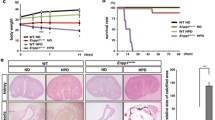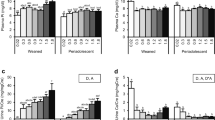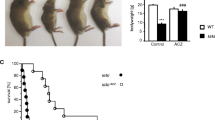Abstract
Homozygous Klotho mutant (kl −/−) mice exhibit a variety of phenotypes resembling human aging, including arteriosclerosis, infertility, skin atrophy, osteoporosis, and short life span. Calcium abnormality, one of the phenotypes in kl −/− mice, is thought to be due to the elevated gene expression of 25-hydroxyvitamin D3 1α-hydroxylase in the kidney. We studied 25-hydroxyvitamin D3 1α-hydroxylase gene expression using a Klotho plasmid that we had previously constructed for Klotho protein production. It was found that Klotho protein medium upregulated cAMP and the PKC pathway, and suppressed 25-hydroxyvitamin D3 1α-hydroxylase in kidney cells. However, both cAMP and PKC are known to elevate 25-hydroxyvitamin D3 1α-hydroxylase gene expression, therefore, another unknown calcium regulation pathway using Klotho protein medium might exist. Furthermore, we found that activation of the PKC pathway by Klotho was observed only in the kidney and testis, where the Klotho gene is expressed, although activation of the cAMP pathway was observed in any kind of cell. These data suggest that calcium regulation through 25-hydroxyvitamin D3 1α-hydroxylase by Klotho depends on non-cAMP and a non-PKC pathway and that the Klotho protein may have different signaling pathways, depending on the Klotho gene expression in different cells and organs.
Similar content being viewed by others
References
Kuro-o, M., Matsumura, Y., Aizawa, H., et al. (1997). Nature 390, 45–51.
Nabeshima, Y. (2002). Ageing Res. Rev. 1, 627–638.
Matsumura, Y., Aizawa, H., Shiraki-Iida, T., Nagai, R., Kuro-o, M., and Nabeshima, Y. (1998). Biochem. Biophys. Res. Commun. 242, 626–630.
Shiraki-Iida, T., Aizawa, H., Matsumura, Y., et al. (1998). FEBS Lett. 424, 6–10.
Saito, Y., Yamagishi, T., Nakamura, T., et al. (1998). Biochem. Biophys. Res. Commun. 248, 324–329.
Takahashi, Y., Kuro, O. M., and Ishikawa, F. (2000). Proc. Natl. Acad. Sci. USA 97, 12407–12408.
Imura, A., Iwano, A., Tohyama, O., et al. (2004). FEBS Lett. 565, 143–147.
Koh, N., Fujimori, T., Nishiguchi, S., et al. (2001). Biochem. Biophys. Res. Commun. 280, 1015–1020.
Kamitani, A., Yamada, H., Kinuta, M., et al. (2002). Biochem. Biophys. Res. Commun. 294, 261–267.
Miyamoto, K., Ito, M., Segawa, H., and Kuwahata, M (2003). Nephrol. Dial. Transplant. 18(Suppl. 3), iii79–80.
Yoshida, T., Fujimori, T., and Nabeshima, Y. (2002). Endocrinology 143, 683–689.
Tsujikawa, H., Kurotaki, Y., Fujimori, T., Fukuda, K., and Nabeshima, Y. (2003). Mol. Endocrinol. 17, 2393–2403.
Takeyama, K., Kitanaka, S., Sato, T., Kobori, M., Yanagisawa, J., and Kato, S. (1997). Science 277, 1827–1830.
Yoshida, N., Yoshida, T., Nakamura, A., Monkawa, T., Hayashi, M., and Saruta, T. (1999). J. Am. Soc. Nephrol. 10, 2474–2479.
Yoshida, T., Yoshida, N., Nakamura, A., Monkawa, T., Hayashi, M., and Saruta, T. (1999). J. Am. Soc. Nephrol. 10, 963–970.
Yang, J., Matsukawa, N., Rakugi, H., et al. (2003). Biochem. Biophys. Res. Commun. 301, 424–429.
Kato, Y., Arakawa, E., Kinoshita, S., et al. (2000). Biochem. Biophys. Res. Commun. 267, 597–602.
Deluca, H. F. and Cantorna, M. T. (2001). FASEB J. 15, 2579–2585.
Niwa, H., Yamamura, K., and Miyazaki, J. (1991). Gene 108, 193–199.
Bradford, M. M. (1976). Anal. Biochem. 72, 248–254.
Walton, G. M., Bertics, P. J., Hudson, L. G., Vedvick, T. S., and Gill, G. N. (1987). Anal. Biochem. 161, 425–437.
Sukumaran, S. K. and Prasadarao, N. V. (2002). J. Biol. Chem. 277, 12253–12262.
Zhao, L. and Brinton, R. D. (2003). J. Neurosci. 23, 4228–4239.
Author information
Authors and Affiliations
Corresponding author
Rights and permissions
About this article
Cite this article
Imai, M., Ishikawa, K., Matsukawa, N. et al. Klotho protein activates the PKC pathway in the kidney and testis and suppresses 25-hydroxyvitamin D3 1α-hydroxylase gene expression. Endocr 25, 229–234 (2004). https://doi.org/10.1385/ENDO:25:3:229
Received:
Revised:
Accepted:
Issue Date:
DOI: https://doi.org/10.1385/ENDO:25:3:229




